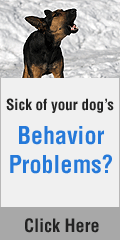Pet Dog Health: The Danger Of Stomach Torsion
Author: David McMahonIt may be the worst thing that can happen to a dog owner: coming home and finding your "best friend" suddenly dead-when the dog had seemed completely healthy. Unfortunately that's exactly what happened to me one October afternoon, when I came home to find one of my German Shepherds dead on the floor. What could it be? A stroke? A heart attack? After getting over my complete state of shock-the dog was not "aged" and seemed completely healthy-I began digging for answers.
It turned out that the cause of death was an event called "stomach torsion" that comes about from "bloat". This is a serious issue in pet dog health, its the second leading cause of death for large dogs. But at the time, I didn't know very much about it.
Becoming educated on this issue could mean the difference between death and several extra years of life for your dog.
OK-so what is it? Let's try and describe it in laymen's terms. Bloat is basically a condition where a lot of gas or fluid gets trapped in the dogs stomach. This really isn't all that different from what might happen to you if you drank too much root beer on a full stomach, but in dogs, and in particular large dogs, this is a serious problem. This is because the stomach isn't as well set in the body cavity as ours is, a dogs stomach is kind of hanging loose if you will. When it becomes over-engorged with fluid or gas, it can twist around.
When it does, the result is a medical emergency. The blood supply to many vital organs gets cut off when this happens, and the dog goes into shock. Death will result if surgery is not performed. A symptom that this is happening is that the dog will be throwing up clear liquid or attempting to throw up.
One tragic aspect of this condition is that onset can happen rapidly, and so you may become aware of it when its too late. That's what happened in my case, my dog was fine when I left the house. I was gone for a few hours, and when I got back she was dead. Its a sad state of affairs but the progression from bloat to stomach torsion to death can happen in as little as an hour.
We can't be with our dogs 24 hours a day 7 days a week, but what we can do is take steps to reduce the risk of it happening. Here are a few things you can do:
- Break up your dogs feedings. The less food a dog takes in when it eats the lower the risk. A dog that eats just once a day has a higher risk than a dog that has its meals split into two or three portions a day.
- Watch out for dry food. Dogs that eat all dry food have a higher risk. Consider feeding canned food, or mixing dry and canned together. When you do this substitute a can of moist dog food for a cup of dry food. This helps because dry food tends to expand when liquified in the stomach adding stress to the stomach.
- Feed using raised bowls. There is a bit of controversey about this one, but feeding using raised bowls may help reduce the risk. This is because some dogs gulp down air when they eat, and its believed by some that bowls raised off the floor cut down on the amount of air gulped in. This in turn cuts the risk of bloat happening. Raised pet bowls are available for sale on the internet.
- Watch out for diarrhea. If a dog has chronic diarrhea, it may increase the risk. Make sure to get diarrhea treated.
- Never exercise right after feeding. Let the dogs stomach "settle" for an hour or two before going out for exercise.
- Avoid feeding immediately after exercise. After a long walk, a dog probably wants to drink lots of water. Doing that and then eating can be a fatal recipie.
- Don't feed late at night.
Before this happens I had no idea what a serious problem this was in pet dog health. Interestingly, it often takes dogs in their prime: most victims are aged between 4 and 7 years of age. But dogs of any age can get it, and although males have a higher risk, female dogs die from it as well.
In the end we can't prevent every bad event from happening. But at least taking these steps will put your mind at rest since you'll know you were aware, and took responsible steps to control the risk.
More information on pet dog health: click here
About the Author:Article Source: http://www.articlesbase.com/pets-articles/pet-dog-health-the-danger-of-stomach-torsion-815044.html




